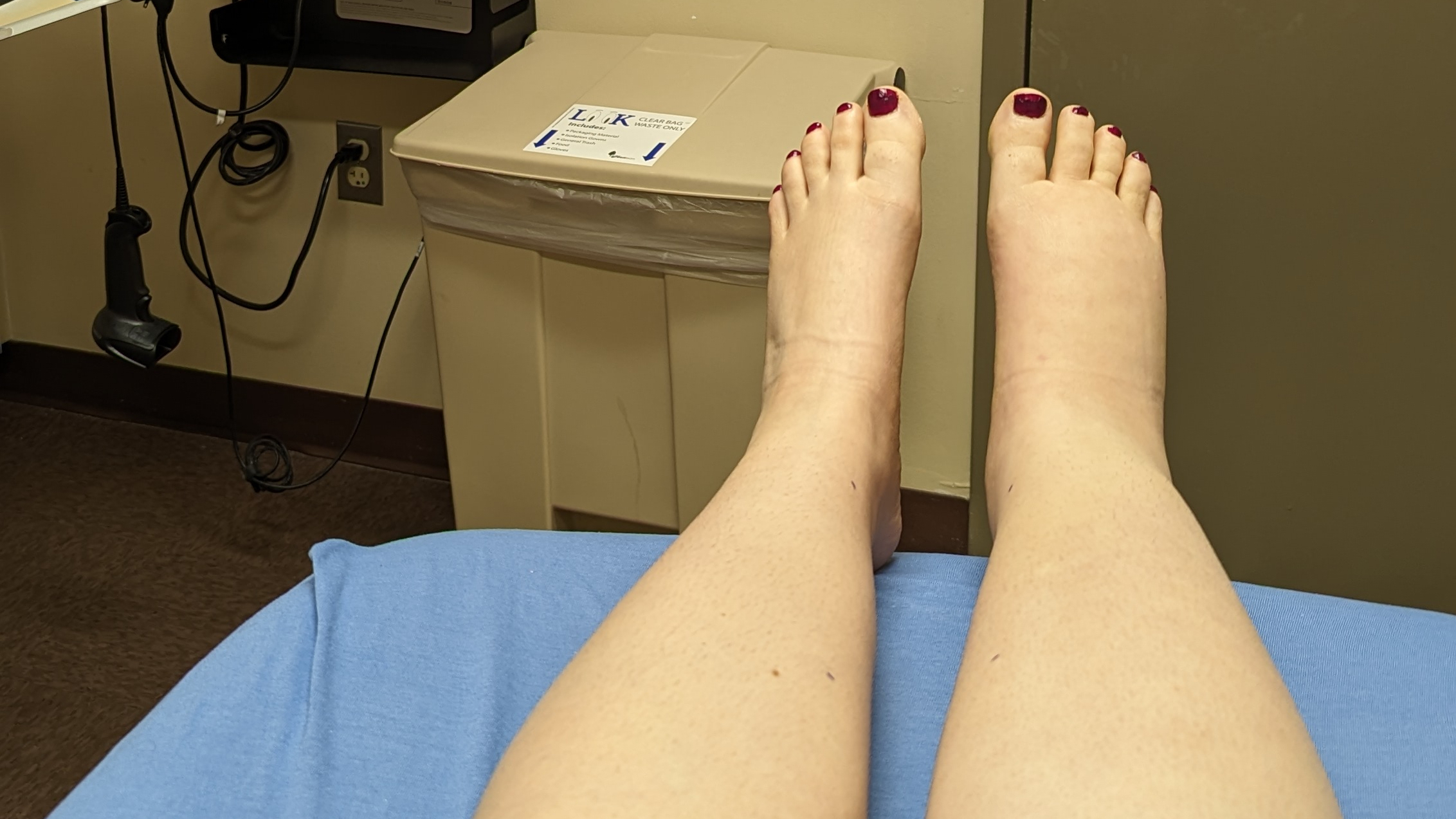The blog has been quiet lately, but with good reason: I got a new job!
I began last fall with the marketing and communications department of a large health care system and I love it, although since I’ve started, I haven’t had time for much else. Now that a few months have passed, I’m slowly but surely getting things settled into a routine – including my lymphedema.
Adjusting to a new routine
Before starting the job, I was a little nervous about how sitting at a desk all day would affect my swelling. I’ve mostly worked jobs where I’ve had time to recharge and elevate between shifts or during days off: I’ve cleaned houses and hotel rooms, baked pies, sold antiques – but a professional, full-time office job with a regular schedule? Totally new ground for both me and my leg.
To prepare, I revisited a post my lymphie friend Grace wrote on her blog a few years back called “A Lymphie’s Guide to the Workplace” – an awesome resource with lots of great tips for desk-bound lymphies.
I also made sure to get the appropriate accommodations cleared with my new employer, who provided me with a footstool so that I can elevate beneath my desk.

Despite all the prep, I still had some concerns. Here are four worries I had about managing lymphedema in the workplace, and how I’ve adapted over the months since.
1. Sitting at a desk all day long
Unlike the cardiovascular system, the lymphatic system doesn’t have a pump to keep lymph moving: instead, it depends on one-way valves and the movement of surrounding muscles and joints, whose contractions help push the fluid up to the subclavian veins at the base of the neck where the filtered lymph rejoins the bloodstream.
Needless to say, sitting all day long with a compromised lymphatic system puts a serious kink in the hose and can aggravate existing swelling.
Solution: Get up from my desk every hour or so. Whether it’s a walk to the bathroom (my coworkers must think I have the tiniest bladder!) or to the kitchenette to refill my water bottle, I gotta get up and move my lymph.
Standing also helps. I recently asked my employer for a standing desk converter, and being able to alternate between sitting and standing has been such a huge relief. Not just for my swelling, either: sitting for too long makes my compression garment pinch behind my knee, and standing alleviates that for me.
Sometimes short walks and standing at your desk aren’t enough, though. If you’re inclined to give it a try, there are exercises you can do at your desk as well as decongestive and breathing exercises specific to lymphedema, too.
2. Wearing compression at work
It’s weird: I’ve reached the point where I’m okay with wearing my compression openly out in public, yet I was suddenly nervous about wearing it around the office. I guess it’s because these wouldn’t be passing strangers, but rather people I see every day. Would they notice my leg? Would they care?

Solution: Remind myself of my priorities. My health and physical comfort comes before any worries about what other people may think. For better or worse, my lymphedema is a part of me, and that means my compression garment will always be a part of my outfit.
So, I’ve been wearing my compression garment – sometimes openly, other times hidden by longer pants – and everyone has been great about it. (Some I think haven’t even noticed!) Either way, I’m happy to lymphsplain when asked about my leg: working in the medical industry means my coworkers are not only understanding, but are genuinely curious to learn about it.
Plus, I like the idea of normalizing the sight of someone wearing a compression garment. Maybe one of my coworkers will see someone wearing compression out at the grocery store or walking down the street, and now they’ll be able to recognize it. How neat is that?
3. Physiological effects
Before starting the job, I was concerned what physiological effects this change in routine would have on my swelling. My lymphedema can be sensitive, and there was a definite period of adjustment during the first week or so where both legs were noticeably puffier.
Solution: Paying extra attention to my lymphedema limb and responding with action. Is it feeling denser than usual? Heavier? Is there a dull aching pain, or pins and needles? If I notice anything that feels different than my baseline, I try best I can to address it, be it by elevating, going for a quick walk, or using my compression pump when I get home.
Oh – and drinking water. Lymph fluid has a high protein content, so staying hydrated is crucial for lymphies as it helps flush out the excess protein from tissues.
4. Time management
Work, the blog, time with friends and family, errands, housekeeping, lymphedema treatment… it all starts to pile up after a while, and it’s unavoidable that one area of life (or two, or three) eventually falls by the wayside.
Living with a chronic condition like lymphedema means we have to be intentional in the choices we make around how – and on what – we spend our time, because when we get overwhelmed and worn down, our health usually gets worn down, too.
Solution: I’m still figuring this one out. There’s a lot I’d like to do, but I don’t always have enough energy or time to do it all. A good planner helps me stay organized, but the biggest thing for me right now is being mindful of not spreading myself too thin; I’m no good to myself or anybody else if I’m sleep-deprived, cranky, and stressed out.
Like I said, time management is still a work in progress for me – but then again, so are most things!





Leave a Reply to MarciaCancel reply